厦门大学研究生《高级微观经济学(I)》课程复习资料
- 格式:doc
- 大小:310.00 KB
- 文档页数:8

期末复习指南第二部分:厂商理论一、叙述题1.厂商利润最大化条件的意义及应用边界;厂商成本最小化条件的意义及应用边界(新加)(1)写出利润最大化的形式化描述。
(2)利润最大化的一阶条件和意义(三个)。
(3)应用边界:生产函数不能微分;某些投入要素可能取0值;可能不存在利润最大化生产技术。
(4)写出成本最小化的形式化描述。
(5)成本最小化的一阶条件和意义。
2.分析生产集的性质(1)非空的;(2)闭凸;(3)没有免费的午餐;(4)不生产是可能的;(5)自由处置;(6)不可逆性;(7)规模报酬;(8)可加性。
3.阐述欧拉方程和克拉克分配定理的理论意义和现实意义。
(1)欧拉方程:),(212211x x kf f x f x =+经济意义:投入要素x 1和x 2与其边际产品的乘积之和等于k 倍的产出量。
(2)克拉克定理:),(212211x x f f x f x =+经济意义:总产出可按投入要素的边际产品完全分配。
(3)现实意义:每种投入按其边际产出将全部产品耗尽 按这种理论分析,则最大化长期利润等于0(长期每种生产要素都可以调整)。
4.证明利润函数是价格的凸函数。
令价格分别为p p p ''',,时的产出为y y y ''',,,其中p p p '-+='')1(t ty p y p y p p y p p '''-+''='''-+=''''='')1(])1([)(t t t t πpy y p ≤''(因为y 是价格p 下的利润最大化产出,其他产出的利润都小于py )同理,y p y p ''≤''',代入(*)得到:)()1()()1()(p p y p py p '-+=''-+≤''πππt t t t5.给出要素需求函数、条件要素需求函数、成本函数及利润函数形式化描述,并解释经济意义。
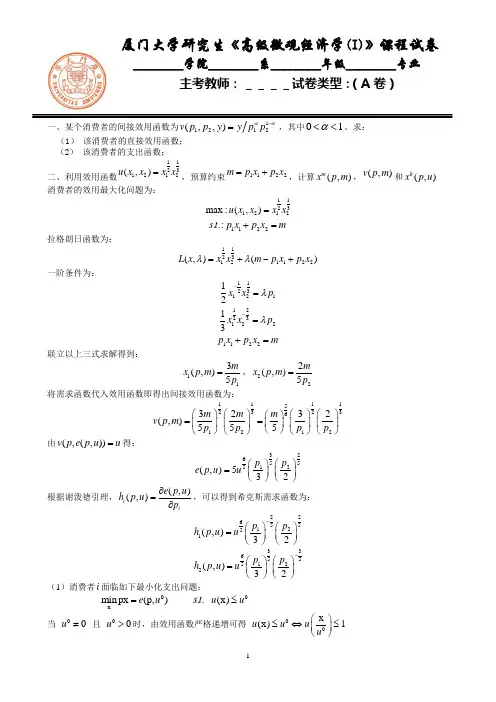
一、某个消费者的间接效用函数为αα-=12121),,(p p y y p p v ,其中10<<α。
求:(1) 该消费者的直接效用函数;(2) 该消费者的支出函数;二、利用效用函数11321212(,)u x x x x=,预算约束1122m p x p x =+,计算(,)mx p m ,(,)v p m 和(,)hx p u消费者的效用最大化问题为:11321212max :(,)u x x x x =1122..:s t p x p x m +=拉格朗日函数为:1132121122(,)()L x x x m p x p x λλ=+-+一阶条件为:113212112x x p λ-= 213212213x x p λ-= 1122p x p x m +=联立以上三式求解得到:113(,)5m x p m p =,222(,)5mx p m p = 将需求函数代入效用函数即得出间接效用函数为:111152323612123232(,)555m m m v p m p p p p ⎛⎫⎛⎫⎛⎫⎛⎫⎛⎫== ⎪ ⎪ ⎪ ⎪ ⎪⎝⎭⎝⎭⎝⎭⎝⎭⎝⎭由(,(,))v p e p u u =得:32655125(,)532p p e p u u ⎛⎫⎛⎫= ⎪ ⎪⎝⎭⎝⎭根据谢泼德引理,(,)(,)i ie p u h p u p ∂=∂,可以得到希克斯需求函数为: 226551251(,)32p p h p u u -⎛⎫⎛⎫= ⎪ ⎪⎝⎭⎝⎭336551252(,)32p p h p u u -⎛⎫⎛⎫= ⎪ ⎪⎝⎭⎝⎭(1)消费者i 面临如下最小化支出问题:0xmin px (p,)e u = ..s t 0(x)u u ≤当 00u ≠ 且 00u >时,由效用函数严格递增可得 00x (x)1u u u u ⎛⎫≤⇔≤⎪⎝⎭厦门大学研究生《高级微观经济学(I)》课程试卷____学院____系____年级____专业主考教师:____试卷类型:(A 卷)∴ 原问题转化为: 000x min p (p,1)u u e u⋅=⋅ ..s t 0x 1u u ⎛⎫≤ ⎪⎝⎭这表明,0(p,)(p,1)e u u e =⋅;显然,当00u =时,该式子亦成立。
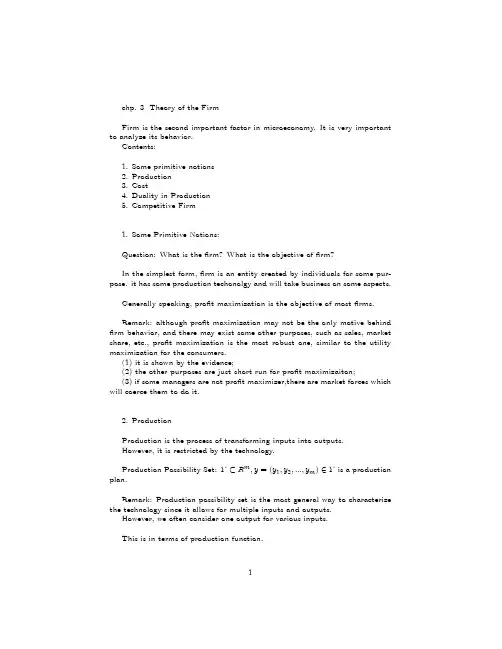
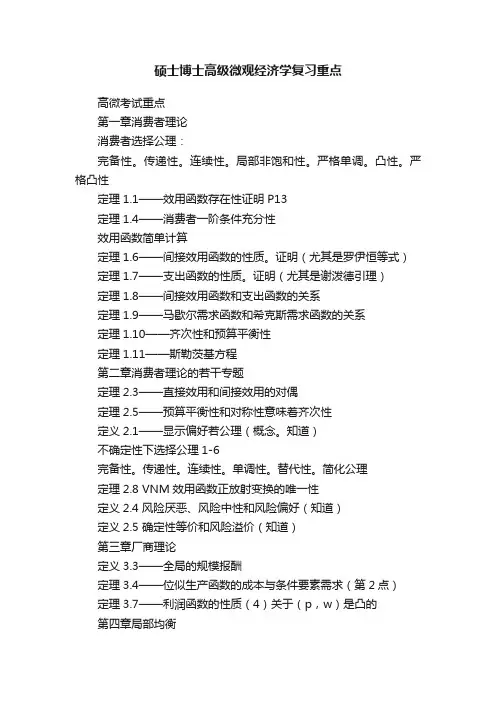
硕士博士高级微观经济学复习重点高微考试重点第一章消费者理论消费者选择公理:完备性。
传递性。
连续性。
局部非饱和性。
严格单调。
凸性。
严格凸性定理1.1——效用函数存在性证明P13定理1.4——消费者一阶条件充分性效用函数简单计算定理1.6——间接效用函数的性质。
证明(尤其是罗伊恒等式)定理1.7——支出函数的性质。
证明(尤其是谢泼德引理)定理1.8——间接效用函数和支出函数的关系定理1.9——马歇尔需求函数和希克斯需求函数的关系定理1.10——齐次性和预算平衡性定理1.11——斯勒茨基方程第二章消费者理论的若干专题定理2.3——直接效用和间接效用的对偶定理2.5——预算平衡性和对称性意味着齐次性定义2.1——显示偏好若公理(概念。
知道)不确定性下选择公理1-6完备性。
传递性。
连续性。
单调性。
替代性。
简化公理定理2.8 VNM效用函数正放射变换的唯一性定义2.4 风险厌恶、风险中性和风险偏好(知道)定义2.5 确定性等价和风险溢价(知道)第三章厂商理论定义3.3——全局的规模报酬定理3.4——位似生产函数的成本与条件要素需求(第2点)定理3.7——利润函数的性质(4)关于(p,w)是凸的第四章局部均衡补偿变化(或叫收入变差,CV)和等价变差的计算(等价变化,EV,这个书上没有。
见PPT)第五章一般均衡定理5.2——总超额需求函数的特性定理5.3——总超额需求与瓦尔拉斯均衡(瓦尔拉斯一般均衡存在性的条件,知道)定理5.7 第一福利定理定理5.8 第二福利定理第六章一般均衡定义7.2——严格占优策略定义7.7——纯策略纳什均衡。
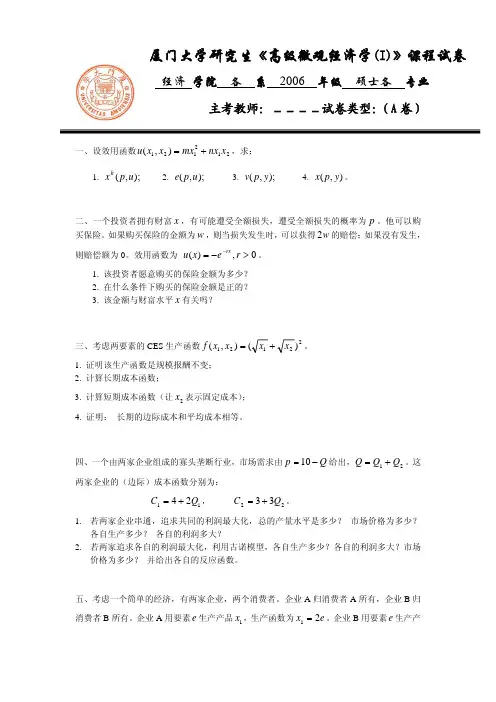
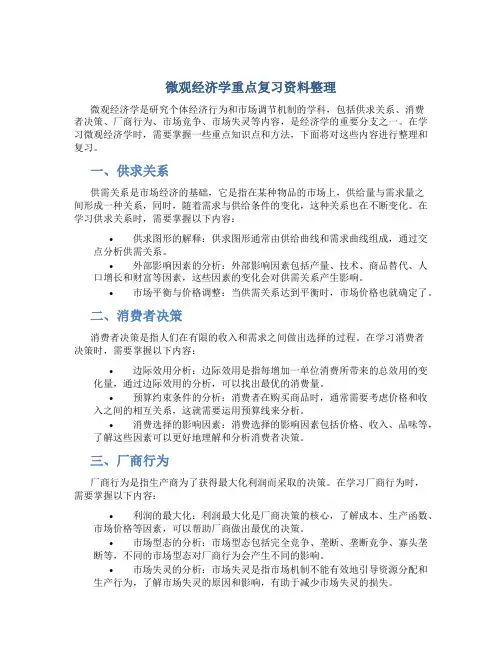
微观经济学重点复习资料整理微观经济学是研究个体经济行为和市场调节机制的学科,包括供求关系、消费者决策、厂商行为、市场竞争、市场失灵等内容,是经济学的重要分支之一。
在学习微观经济学时,需要掌握一些重点知识点和方法,下面将对这些内容进行整理和复习。
一、供求关系供需关系是市场经济的基础,它是指在某种物品的市场上,供给量与需求量之间形成一种关系,同时,随着需求与供给条件的变化,这种关系也在不断变化。
在学习供求关系时,需要掌握以下内容:•供求图形的解释:供求图形通常由供给曲线和需求曲线组成,通过交点分析供需关系。
•外部影响因素的分析:外部影响因素包括产量、技术、商品替代、人口增长和财富等因素,这些因素的变化会对供需关系产生影响。
•市场平衡与价格调整:当供需关系达到平衡时,市场价格也就确定了。
二、消费者决策消费者决策是指人们在有限的收入和需求之间做出选择的过程。
在学习消费者决策时,需要掌握以下内容:•边际效用分析:边际效用是指每增加一单位消费所带来的总效用的变化量,通过边际效用的分析,可以找出最优的消费量。
•预算约束条件的分析:消费者在购买商品时,通常需要考虑价格和收入之间的相互关系,这就需要运用预算线来分析。
•消费选择的影响因素:消费选择的影响因素包括价格、收入、品味等,了解这些因素可以更好地理解和分析消费者决策。
三、厂商行为厂商行为是指生产商为了获得最大化利润而采取的决策。
在学习厂商行为时,需要掌握以下内容:•利润的最大化:利润最大化是厂商决策的核心,了解成本、生产函数、市场价格等因素,可以帮助厂商做出最优的决策。
•市场型态的分析:市场型态包括完全竞争、垄断、垄断竞争、寡头垄断等,不同的市场型态对厂商行为会产生不同的影响。
•市场失灵的分析:市场失灵是指市场机制不能有效地引导资源分配和生产行为,了解市场失灵的原因和影响,有助于减少市场失灵的损失。
四、市场竞争市场竞争是市场经济的重要特征之一,它可以促进资源的优化配置和生产效率的提高。
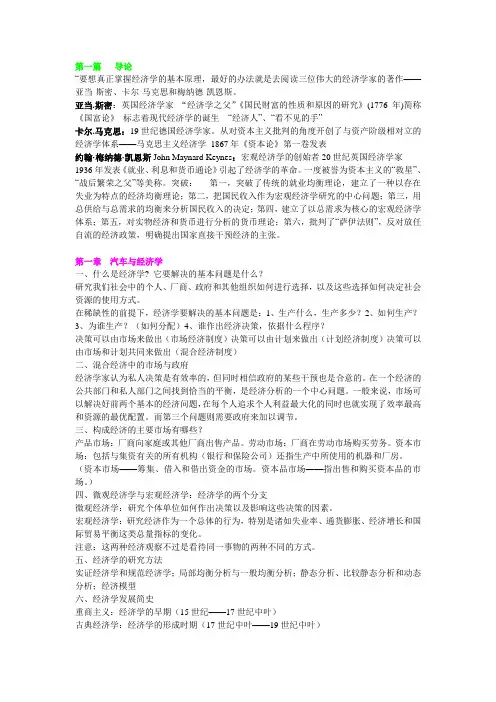
第一篇导论―要想真正掌握经济学的基本原理,最好的办法就是去阅读三位伟大的经济学家的著作——亚当·斯密、卡尔·马克思和梅纳德·凯恩斯。
亚当.斯密:英国经济学家“经济学之父”《国民财富的性质和原因的研究》(1776年)简称《国富论》标志着现代经济学的诞生―经济人‖、―看不见的手‖卡尔.马克思:19世纪德国经济学家。
从对资本主义批判的角度开创了与资产阶级相对立的经济学体系——马克思主义经济学1867年《资本论》第一卷发表约翰·梅纳德·凯恩斯John Maynard Keynes:宏观经济学的创始者20世纪英国经济学家1936年发表《就业、利息和货币通论》引起了经济学的革命。
一度被誉为资本主义的―救星‖、―战后繁荣之父‖等美称。
突破:第一,突破了传统的就业均衡理论,建立了一种以存在失业为特点的经济均衡理论;第二,把国民收入作为宏观经济学研究的中心问题;第三,用总供给与总需求的均衡来分析国民收入的决定;第四,建立了以总需求为核心的宏观经济学体系;第五,对实物经济和货币进行分析的货币理论;第六,批判了―萨伊法则‖,反对放任自流的经济政策,明确提出国家直接干预经济的主张。
第一章汽车与经济学一、什么是经济学? 它要解决的基本问题是什么?研究我们社会中的个人、厂商、政府和其他组织如何进行选择,以及这些选择如何决定社会资源的使用方式。
在稀缺性的前提下,经济学要解决的基本问题是:1、生产什么,生产多少?2、如何生产?3、为谁生产?(如何分配)4、谁作出经济决策,依据什么程序?决策可以由市场来做出(市场经济制度)决策可以由计划来做出(计划经济制度)决策可以由市场和计划共同来做出(混合经济制度)二、混合经济中的市场与政府经济学家认为私人决策是有效率的,但同时相信政府的某些干预也是合意的。
在一个经济的公共部门和私人部门之间找到恰当的平衡,是经济分析的一个中心问题。
一般来说,市场可以解决好前两个基本的经济问题,在每个人追求个人利益最大化的同时也就实现了效率最高和资源的最优配置。

2021 年厦门大学 806 宏、微观经济学考研精编资料一、厦门大学 806 宏、微观经济学考研真题汇编及考研大纲1 .厦门大学 806 宏、微观经济学 2002--2017 年考研真题;其中 2005-2016 有答案、 2017 含部分答案、2. 厦门大学 806宏、微观经济学考研大纲①2018年厦门大学806宏、微观经济学考研大纲。
二、 2021 年厦门大学 806 宏、微观经济学考研资料3 .平狄克《微观经济学》考研相关资料( 1 )平狄克《微观经济学》 [ 笔记 + 课件 + 提纲 ]①厦门大学 806 宏、微观经济学之平狄克《微观经济学》考研复习笔记。
②厦门大学 806 宏、微观经济学之平狄克《微观经济学》本科生课件。
③厦门大学 806 宏、微观经济学之平狄克《微观经济学》复习提纲。
( 2 )平狄克《微观经济学》考研核心题库(含答案)①厦门大学 806 宏、微观经济学考研核心题库之平狄克《微观经济学》简答题精编。
②厦门大学 806 宏、微观经济学考研核心题库之平狄克《微观经济学》论述题精编。
③厦门大学 806 宏、微观经济学考研核心题库之平狄克《微观经济学》综合题精编。
( 3 )平狄克《微观经济学》考研模拟题 [ 仿真 + 强化 + 冲刺 ]① 2021 年厦门大学 806 宏、微观经济学之微观经济学考研专业课六套仿真模拟题。
② 2021 年厦门大学 806 宏、微观经济学之微观经济学考研强化六套模拟题及详细答案解析。
③ 2021 年厦门大学 806 宏、微观经济学之微观经济学考研冲刺六套模拟题及详细答案解析。
4 .曼昆《宏观经济学》考研相关资料( 1 )曼昆《宏观经济学》 [ 笔记 + 课件 + 提纲 ]①厦门大学 806 宏、微观经济学之曼昆《宏观经济学》考研复习笔记。
②厦门大学 806 宏、微观经济学之曼昆《宏观经济学》本科生课件。
③厦门大学 806 宏、微观经济学之曼昆《宏观经济学》复习提纲。
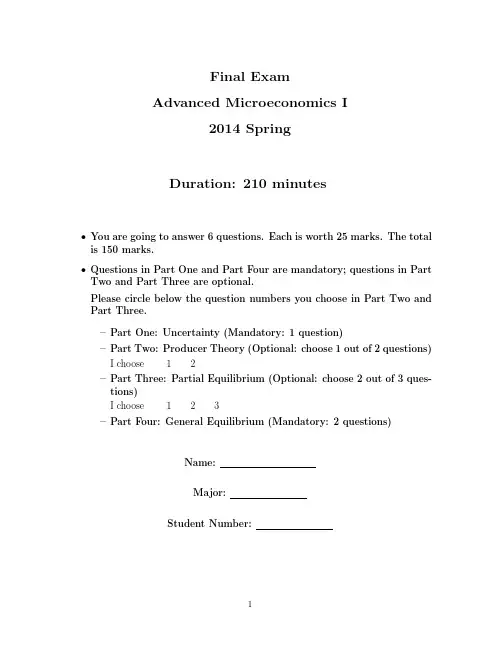
Final ExamAdvanced Microeconomics I2014SpringDuration:210minutes•You are going to answer6questions.Each is worth25marks.The total is150marks.•Questions in Part One and Part Four are mandatory;questions in Part Two and Part Three are optional.Please circle below the question numbers you choose in Part Two and Part Three.–Part One:Uncertainty(Mandatory:1question)–Part Two:Producer Theory(Optional:choose1out of2questions)I choose12–Part Three:Partial Equilibrium(Optional:choose2out of3ques-tions)I choose123–Part Four:General Equilibrium(Mandatory:2questions)Name:Major:Student Number:Part One:Question1(mandatory)Suppose you and I consider the following game:we both put$50on the table,thenflip a coin.If it comes up heads,I get everything on the table;and if it comes up tails,you get everything on the table.Suppose we both have$150available for consumption this week and both of us are risk averse with the same Bernoulli utility function u(x)=ln x,where x is the weekly consumption.(a)(2marks)Draw a curve showing the relationship between your weekly consumption x andutility u.(b)(2marks)Clearly label the expected value of the gamble E(x)and the expected utilityEU from playing the gamble,assuming the coin is fair,i.e,the coin comes up with heads half the time and tails the other half.(c)(2marks)Will you agree to play the gamble?Explain why or why not.(d)(4marks)Suppose you know the coin is ingδfor the probability of tails comingup,write down an inequality to show that if the coin is sufficiently unfair you will play the gamble.(e)(6marks)Consider both of us in a context of an Edgeworth Box,and suppose that the coinis fair.Draw the Edgeworth Box with consumption x H under”heads”on the horizontal and consumption x T under”tails”on the vertical axis.Illustrate our endowment point E before the gamble and outcome bundle A if we do the gamble.Show the four indifference curves,two for you and two for me,going through point E and A.Explain why it is NOT efficient for us to play the gamble.(f)(2marks)Suppose that I know the coin is unfair and that it comes up tails with aprobability ofδ<0.5.How would the slope of my indifference curve at point E differ from what you draw in the previous question?(g)(3marks)Suppose that I know that the coin is unfair and it comes up tails with aprobability ofδ<0.5.You still believe the coin is fair.To make you accept the gamble,I sweetened the terms for you:if the coin comes up heads,I agree to give you k out of my winnings.Draw a new Edgeworth Box with the endowment bundle E,the outcome bundleA in the previous gamble and the new outcome bundleB in the new gamble.Indicate kin the diagram.(h)(4marks)Write down an equation ofδand k to show the condition under which takingthe gamble is Pareto efficient.Part Two:Question1(optional)Consider a constant-returns to scale Cobb-Douglas technology using two inputsf(K,L)=AKαL1−αwhere0<α<1.(a)(8marks)Derive the cost function.(b)(3marks)Show that long-run average and long-run marginal cost are constant and equal.(c)(4marks)Fix input K at K and derive the short-run cost function.(d)(7marks)Show that for every level of K,short-run average cost and long-run averagecost are equal at the minimum level of short-run average cost.(e)(3marks)Illustrate your results in the cost-output plane.Part Two:Question2(optional)The market for commodity q is perfectly competitive.All potentialfirms have the identicalshort run cost functionc(w,k,q)=w2q2k+9kwhere w is the wage rate and k is the short runfixed level of capital.Now let the wage rate be determined by the aggregate output level of q,denoted as Q,according to the equation w(Q)=0.1Q.The market demand for q isQ d(p)=1600−p(a)(8marks)What is the long run supply curve for q?(b)(9marks)What is the long run competitive equilibrium price of q,total market outputQ,and wage rate?(c)(8marks)What can you say about the number offirms,and the aggregate amount ofcapital in the long run for this market?Part Three:Question1(optional)Consider a market of differentiated product duopoly where twofirms(1and2)sell the same physical good.Eachfirm i∈{1,2}chooses both the product price p i∈R and retail location x i∈[0,1].Suppose in thefirst stage,bothfirms choose locations x i’s on[0,1].Eachfirm observes the other’s location choice.In the second stage,the twofirms set prices p1and p2 simultaneously.The marginal cost of producing one unit of the good is the same for both firms:c>0.Each consumer is indexed by his/her location y on[0,1].And suppose the consumer population is uniformly distributed on[0,1].A location-y consumer’s utility from buying a unit of good at location x i and price p i is10−t(y−x i)2−p i,where p i is the price of the good,|y−x i|is the consumer’s distance from the retail location,t∈(0,1)is some parameter,and t(y−x i)2 the“transportation cost.”(a)(10marks)Let usfirst investigate the second-stage price competition,fixing thefirms’locations x1=a and x2=1−b(without loss of generality,suppose a+b≤1,i.e.x1≤x2).(1)(5marks)Derive the demand function for thefirms:D1(p1,p2)and D2(p1,p2).(Hint:your answer should be two demand functions of(p1,p2)with parameters a,b and t).(2)(5marks)Given the locations(a,b),eachfirm i maximizes its profitπi(a,b)=(p i−c)D i(p1,p2).Derive the Nash equilibrium prices:p∗1(a,b)and p∗2(a,b).(Hint:youranswer should be functions of a,b with parameters c and t).(b)(10marks)Now let us consider thefirst-stage location competition given the price com-petition derived in part(a).(1)(5marks)Show that while choosing their locations in thefirst stage,firms have anincentive to differentiate maximally,i.e.dπ1(a,b)da <0anddπ2(a,b)db<0(2)(5marks)In the outcome of the entire game(both location and price choices),whatis the equilibrium price markup,i.e.difference between price and marginal cost?(c)(5marks)Suppose a social planner chooses the twofirms’locations to maximize the sumof consumer and producer surplus;and then thefirms compete on prices as in part(a)of the question.What locations would the social planner choose?Part Three:Question2(optional)w12r12x2+F,where w represents All coffee shops in a town have cost function C(w,r,x)=3500per unit labour cost,r represents per unit capital service cost,x represents the number of cups of coffee served and F representsfixed costs.(a)(4marks)Suppose w=25and r=9,find the long-run equilibrium price of a cup of coffeeas a function of F.(b)(2marks)The government is considering to impose a recurring weekly license fee.Beforethe introduction of the license fee,a coffee shop’s weeklyfixed cost is$144.The license fee is$81.Show the impact of the license fee on the long-run equilibrium coffee price. (c)(5marks)Suppose that tastes for coffee x and a composite good y can be characterizedby the utility function u(x,y)=15x12+y for all100,000coffee consumers in the town.Assume that all consumers have a budget of$100for x and y and p y=1.Derive the individual consumer’s demand function for coffee.To evaluate the license fee’s impact on consumers’welfare,will different measures of welfare change,compensating variation, equivalent variation and consumer surplus,give different numbers?Explain why.(d)(2marks)How many cups of coffee are sold in the town before and after the impositionof the license fee?(e)(4marks)How many coffee shops are active in long-run equilibrium before and after theimposition of the license fee?(f)(8marks)What is the deadweight loss associated with the license fee?Part Three:Question 3(optional)There are N firms in a market.Each firm has the same cost function c (q i )=k +cq i where c >0,k >0.The market demand is p =a −bQ ,where Q = i q i .(a)(9marks)Suppose entry by new firms is effectively blocked and existing firms competein their choice of quantity.Calculate the equilibrium market price,each firms output and total dead weight loss incurred by the entry barrier.(b)(8marks)Suppose existing firms compete in their choice of price and new entry is stillimpossible.Solve the same problems as (a).(c)(8marks)Suppose free entry and exit is available and that firms compete in their choiceof quantity,what will be the long-run equilibrium number of firms in the market?Part Four:Question1(mandatory)Consider a pure exchange economy with two consumers,i=1,2,and two commodities, l=1,2.The utility functions of the consumers areu1(x1)=x11×x21,u2(x2)=x12+x22.The endowment of consumer1isω1=(7,2)and that of consumer2isω2=(3,2).(a)(6marks)Find the set of Pareto-efficient allocations of this economy.(b)(6marks)Find the core of this economy.(c)(4marks)Find the Walrasian equilibrium and the equilibrium allocation.(d)(2marks)Is consumer1better offat this equilibrium than at the endowment?Whatabout consumer2?(e)(3marks)Do the marginal rates of substitution of the two consumers equal at this equi-librium?Explain why or why not.(f)(4marks)Find an allocation that is in the core of this economy,but not in the core of its2-fold replica.Part Four:Question2(mandatory)Consider an island with two winemakers and two consumers.(a)(10marks)Suppose grapes are freely available on the island.Firm1is entirely ownedby consumer1.It produces red wine(in barrels)with labour input via the production function R=2l.Firm2is entirely owned by consumer2and produces white wine(in barrels)with labour input via the production function W=3l.Each consumer owns and supplies10units of labour,i.e,aggregate labour supply is inelastic.Consumer1’s utility function is u1(R,W)=R0.4W0.6and consumer2’s utility function is u2(R,W)= 10+0.5ln R+0.5ln W.Define and calculate the general equilibrium of this economy.(You can normalize the price of per unit labour to1)(b)(15marks)Suppose there are international markets for red wine and white wine and thewinemakers on the small island are price takers.Vineries on the island produce30tons of grapes per year and it is impossible to ship grapes from elsewhere to the island.The labour requirements for producing one barrel of red wine and white wine are the same asin question(a).In addition,12ton of grapes are needed for one barrel of red wine and35ton of grapes are needed for one barrel of white wine.Write down the unit cost function for red wine and white wine.Suppose the international prices for red wine and white wine are p R=p W=1per barrel.Find the wage rate w l∗,grape price w g∗,red wine output R∗and white wine output W∗in general equilibrium.。
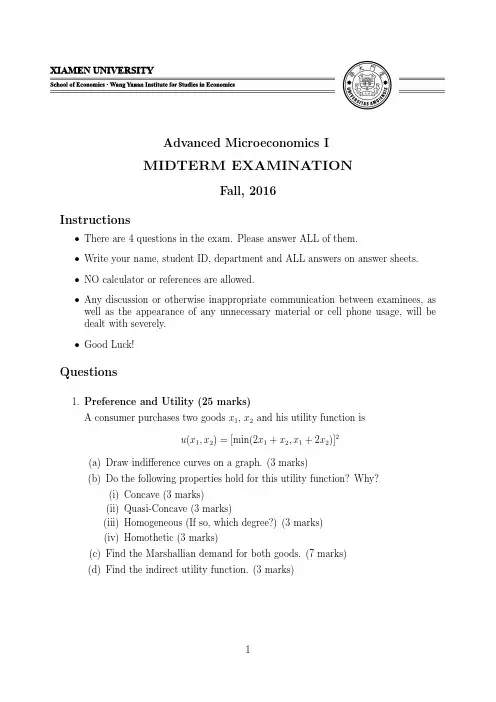

《微观经济学》复习资料完整版微观经济学高鸿业第五版第一章导论第一节经济学的研究对象一、经济学产生的原因:1、经济资源的稀缺性:(1)定义:资源或物品相对于欲望或需要的不充分性而言(资源或物品不能满足欲望或需要)(2)资源或物品的有限性:对任何经济社会,资源或物品总是有限的资源:经济资源与非经济资源(经济资源与否取决于时空的稀缺程度)有形资源与无形资源(技术、知识、信息等)物品:经济品(economic goods):衣服、食品自由品或免费品(free goods):阳光有害品(harmful goods)或废品(waste goods):噪音、垃圾生产要素:土地、劳动、资本、企业家才能等(3)“稀缺”是相对于人们欲望的无限性而言,并非绝对2、欲望或需要的无限性:(1)欲望的特点:多种多样、多层次,由低到高,永无止境,超前性(社会发展的动力)某一欲望的实现总会产生新的欲望,(2)马斯洛的需要(欲望)层次理论:基本生理需要(physiological):人类维持自身生存的最基本要求(包括饥、渴、衣、住、性的方面的要求)生理需要是推动人们行动的最强大的动力只有这些最基本的需要满足到维持生存所必需的程度后,其他的需要才能成为新的激励因素安全需要(safety):人类要求保障自身安全、摆脱事业和丧失财产威胁、避免职业病的侵袭、接触严酷的监督等方面的需要满足后就不再是激励因素社会需要(social):友爱的需要-人人都需要伙伴之间、同事之间关系融洽或保持友谊和忠诚归属的需要-人都有一种归属于一个群体的感情,希望成为群体中的一员,并相互关心和照顾地位需要(esteem):有稳定的社会地位,个人的能力和成就得到社会的承认价值自我实现需要(self actualization):实现个人理想、抱负,发挥个人的能力到最大程度,完成与自己的能力相称的一切事情的需要二、经济学研究的基本问题:资源配置问题和利用问题1、生产什么(what):品种、数量(因时代、生产水平而定)2、如何生产(how):生产者、生产资源、生产技术、生产组织形式(方法)3、为谁生产(for whom):谁来消费生产出来的产品——通过分配取得的收入决定(要素决定收入)4、何时生产(when):资源利用的时间配置,即发展计划(时机选择)5、谁做决策(who):经济体制问题——自给经济、计划经济、市场经济(价格引导生产和消费)混合经济(市场经济为主、政治干预为辅)三、经济学的定义:1、经济学是在一定制度下,研究稀缺资源在各种可供选择的用途中进行合理配置,以及如何更好地利用经济资源生产出(人们需要的)更多物品,以满足人们无限多样需要的一门社会科学。
厦门⼤学研究⽣《⾼级微观经济学(I)》课程复习资料⾼级微观经济学复习题⼀、设某消费者的马歇尔需求函数为1(,),1,2,...,k Lll wx p w k L p===∑,求解如下问题:(⼀)这⼀需求函数在(,)p w 上是零次齐次的吗?(⼆)这⼀需求函数满⾜预算平衡性吗?(三)这⼀需求函数是否满⾜显⽰偏好弱公理(WARP )?(四)求这⼀需求函数的斯卢茨基(替代)矩阵,并判断其是否为(半)负定矩阵以及对称矩阵。
⼆、设市场上只有三种物品,令消费者的效⽤函数为:123123(,,)f q q q q q q =,预算约束为:112233yp q p q p q =++。
假设1212(/)c q q p p q =+为⼀种复合物品,试以c q 的⽅式阐述消费者的最优化问题,并求出c q 的马歇尔需求函数。
三、设消费者的效⽤函数为()ln u w w =。
该消费者现在⾯临⼀个赌局:若他下注x 元,硬币正⾯朝上时他将有()w x +元,正⾯朝下时他将有()w x -元。
设硬币正⾯朝上的概率为π,求解如下问题:(⼀)求证消费者最优赌注x *为π的函数。
(⼆)当1/2π=时,此消费者是否会参加该赌局?如果参加,则会下注多少?试给出解释。
四、设消费者的间接效⽤函数为:12(,),(0,0)v p w wp p αβαβ=<<。
试求消费者对应的直接效⽤函数。
五、⼀个⼚商有两个⽣产车间⽣产同⼀种产品,其中⼀个车间按照成本函数2111()c y y =进⾏⽣产,另⼀个车间按照成本函数2222()c y y =进⾏⽣产,设⼚商的总产量为y ,求该⼚商的成本函数。
六、设某⼀⼚商的⽣产函数为:/12(),(1,01)y x x ρρβρβρ=+<≠<。
求该⼚商的供给函数、条件投⼊需求函数和利润函数。
七、设某⼈的效⽤函数为1212(,)u x x x x =,其收⼊100m =,最初商品价格为0(1,1)p =,假设现在商品价格变化为1(1/4,1)p =,试计算对应的CV 与CS ?。
高级微观经济理论复习资料高级微观经济理论复习资料微观经济学是经济学的一个重要分支,研究个体经济主体(如个人、家庭、企业)的经济行为和市场的运作机制。
高级微观经济理论则是在基础微观经济学的基础上,进一步深入探讨了市场失灵、博弈论、信息经济学等更加复杂的经济现象。
本文将从市场失灵、博弈论和信息经济学三个方面来复习高级微观经济理论。
一、市场失灵市场失灵是指市场机制无法有效分配资源的情况。
其中最常见的市场失灵类型是外部性和公共物品的供给不足。
外部性是指经济活动对于除参与者外的其他人产生的影响,可以是正面的(正外部性)或负面的(负外部性)。
市场无法内部化这些外部性,导致资源无法有效配置。
公共物品则是指无法排除非付费人群使用的物品,如国防、公园等。
由于无法通过市场机制收取费用,私人供应商不愿意提供,导致供给不足。
二、博弈论博弈论是研究决策者在互相影响的情况下做出决策的理论。
博弈论的核心是分析决策者的策略选择和预期收益。
最经典的博弈论模型是囚徒困境。
在囚徒困境中,两名嫌疑人面临合作和背叛两种选择。
如果两人都选择合作,将获得较轻的刑罚;如果两人都选择背叛,将获得较重的刑罚;如果一人选择合作,而另一人选择背叛,背叛者将获得最轻的刑罚,而合作者将获得最重的刑罚。
囚徒困境模型揭示了个体理性行为可能导致整体利益的损失,从而引发了对合作与背叛之间平衡的思考。
三、信息经济学信息经济学研究的是在信息不对称的情况下,市场经济中的问题。
信息不对称是指市场参与者在交易过程中拥有不同的信息。
最典型的例子是道德风险和逆向选择。
道德风险是指在签订合同之后,一方采取了不诚实或不负责任的行为。
逆向选择则是指在信息不对称的情况下,市场上只有低质量产品或服务的供应。
信息不对称导致市场无法实现最优配置,需要通过政府干预或其他机制来解决。
总结:高级微观经济理论是微观经济学的一个重要分支,研究更加复杂的经济现象。
本文从市场失灵、博弈论和信息经济学三个方面进行了复习。
厦门大学微观经济学复习题集第一章一、选择题1、在得出某种商品的个人需求曲线时,下列因素除哪一种外均保持不变?()A 商品本身的价格; B个人偏好;C 其他商品的价格;D 个人收入2、保持所有其他因素不变,某种商品的价格下降,将导致()。
A需求量增加;B需求量减少;C需求增加;D需求减少;3、需求量和价格之所以呈反方向变化,是因为()。
A 收入效应的作用; B替代效应的作用C 收入效应和替代效应同时发生作用;D 以上均不正确;4、有下列因素除哪一种外都会使需求曲线移动?()A 消费者收入变化;B 商品价格变化;C 消费者偏好变化;D 其他相关商品价格变化。
5、商品x和商品y是相互替代的,则x的价格下降将导致()。
A x的需求曲线向右移动;B x 的需求曲线向左移动;C y的需求曲线向右移动;D y 的需求曲线向左移动。
6、某种商品价格下降对其互补品的影响是()。
A 互补品的需求曲线向左移动;B 互补品的需求曲线向右移动;C 互补品的供给曲线向右移动;D 互补品的价格上升。
7、需求的价格弹性是指()。
A 需求函数的斜率;B 收入变化对需求的影响程度;C 消费者对价格变化的反映程度;D 以上说法都正确。
8、如果一条直线型的需求曲线与一条曲线型的需求曲线相切,则在切点处两曲线的需求弹性()。
A 相同;B 不同;C 可能相同也可能不同;9、直线型需求曲线的斜率不变,因此其价格弹性也不变,这种说法()。
A 正确;B 不正确;C 有时正确,有时不正确;D 难以确定。
10、假定某商品的价格从10美元下降到9美元,需求量从70增加到75,则需求为()。
A 缺乏弹性;B 富有弹性;C 单一弹性;D 难以确定。
二、名词解释 (微观部分)1需求量2需求函数3供给量4均衡价格三、简答题1影响商品需求的主要因素有哪些?2影响商品供给的主要因素有哪些?3.为什么稀缺性是产生经济问题的根源?4.大多数人都存在不同程度的“喜新厌旧”,请用消费者行为理论分析这一问题的根源?四、计算题已知某产品的市场需求函数为Q=a-Bp,a,b为正常数。
高级微观经济学复习题一、设某消费者的马歇尔需求函数为1(,),1,2,...,k Lll wx p w k L p===∑,求解如下问题:(一)这一需求函数在(,)p w 上是零次齐次的吗?(二)这一需求函数满足预算平衡性吗?(三)这一需求函数是否满足显示偏好弱公理(WARP )?(四)求这一需求函数的斯卢茨基(替代)矩阵,并判断其是否为(半)负定矩阵以及对称矩阵。
二、设市场上只有三种物品,令消费者的效用函数为:123123(,,)f q q q q q q =,预算约束为:112233yp q p q p q =++。
假设1212(/)c q q p p q =+为一种复合物品,试以c q 的方式阐述消费者的最优化问题,并求出c q 的马歇尔需求函数。
三、设消费者的效用函数为()ln u w w =。
该消费者现在面临一个赌局:若他下注x 元,硬币正面朝上时他将有()w x +元,正面朝下时他将有()w x -元。
设硬币正面朝上的概率为π,求解如下问题:(一)求证消费者最优赌注x *为π的函数。
(二)当1/2π=时,此消费者是否会参加该赌局?如果参加,则会下注多少?试给出解释。
四、设消费者的间接效用函数为:12(,),(0,0)v p w wp p αβαβ=<<。
试求消费者对应的直接效用函数。
五、一个厂商有两个生产车间生产同一种产品,其中一个车间按照成本函数2111()c y y =进行生产,另一个车间按照成本函数2222()c y y =进行生产,设厂商的总产量为y ,求该厂商的成本函数。
六、设某一厂商的生产函数为:/12(),(1,01)y x x ρρβρβρ=+<≠<。
求该厂商的供给函数、条件投入需求函数和利润函数。
七、设某人的效用函数为1212(,)u x x x x =,其收入100m =,最初商品价格为0(1,1)p =,假设现在商品价格变化为1(1/4,1)p =,试计算对应的CV与CS ∆。
高级微观经济学复习题参考答案一、解:(一)由于(设0α>):111(,)(,),1,2,...,()k k LLLll ll l l ww wx p w x p w k Lpp pαααααα========∑∑∑故这一需求函数在(,)p w 上是零次齐次的。
(二)由于:11111(,)()LkL Lk k k kLLk k l ll l pp w p x p w w wp p========∑∑∑∑∑故这一需求函数满足预算平衡性。
(三)运用反证法:假设该需求函数不满足显示偏好弱公理,则对于不同的两个消费束0x 与1x 以及对应的价格向量0p 与1p ,消费者在价格向量为0p 时选择0x ,在价格向量为1p 时选择1x ,但是在0001p x p x ≥时,有1110p x p x ≥。
对相关记号作如下变换:01010011,,(,),(,),,p p p p x p w x x p w x w p x w p x ''''====== 经过上述变换,有:(,),(,)px p w w p x p w w ''''≤≤由(,)p x p w w ''≤,可得:11Lll Lll p ww p ==''≤∑∑即:11LLlll l ww p p =='≤'∑∑同理,由(,)px p w w ''≤,可得:11LLl ll l w wp p =='≤'∑∑因此,由上述两式有:11LLl ll l w wp p=='='∑∑即(,)(,)x p w x p w ''=,这意味着01x x =,与0x 和1x 是不同的消费束矛盾。
故假设不成立,这一需求函数满足显示偏好弱公理。
(四)这一需求函数的斯卢茨基矩阵中的任意元素为:2111(,)(,)(,)10,(,1,2,...,)()l l lk k k LLL l l l l l l x p w x p w S x p w p w w wl k L p p p===∂∂=+∂∂=-+==∑∑∑故对应的斯卢茨基矩阵为:*0...0(,).........0...0L Ls p w ⎡⎤⎢⎥=⎢⎥⎢⎥⎣⎦,显然该矩阵是对称的,而且是半负定的(对应的二次型等于0)。
二、解:消费者的效用最大化问题为:123123123,,112233max :(,,)..:q q q f q q q q q q s t y p q p q p q ==++用1212(/)c q q p p q =+代入消去1q ,消费者的效用最大化问题可以改写为:23223223,,1133max :(,,)()..:c c c q q q c p f q q q q q q q p s t y p q p q =-=+构造拉格朗日函数可得:2232231331(,,,)()()c c c p L q q q q q q q y p q p q p λλ=-+-- 利用最优化问题的一阶条件对拉格朗日函数求偏导数并分别令各偏导数等于0,可得:231222232311232231133/0/()()0/()0/0c c c c L q q q p p p L q q q q q q p p p L q q q q p p L y p q p q λλλ∂∂=-=∂∂=-+-=∂∂=--=∂∂=--=解如上方程组,可得c q 的马歇尔需求函数为:123c y q p =三、解:(一)根据题意,消费者的期望效用函数可以写为:()()(1)()U y u w x u w x ππ=++--用消费者的具体效用函数形式代入,相对应的期望效用函数最大化问题可以写为:max :()ln()(1)ln()xU y w x w x ππ=++--设该最优化问题的解为x *,则x *满足该最优化问题的一阶条件:1()0U y w x w x ππ**-'=-=+-解之可得:(21)x w π*=-,故可得最优赌注x *为π的函数。
(二)当1/2π=时,由第(一)题结论可得:(21)0x w π*=-=,故消费者的最优赌注为0,这意味着消费者不会参加该赌局。
实际上,该消费者的绝对风险厌恶系数为:()1()0()a u w R w u w w''=-=>'故可得该消费者在任何财富水平上均为风险厌恶者,不会选择参加任何带有风险性质的赌局。
四、解:令1w =,则间接效用函数为:12(,1)v p p p αβ=,设消费者对两种商品的需求分别为1x 和2x ,则对应的最优化问题为:121212,1122(,)min :..:1p p u x x p p s t p x p x αβ=+=构造拉格朗日函数可得:12121122(,,)(1)L p p p p p x p x αβλλ=++-利用最优化问题的一阶条件对拉格朗日函数求偏导数并分别令各偏导数等于0,可得:11121121221122/0/0/10L p p p x L p p p x L p x p x αβαβαλβλλ--∂∂=+=∂∂=+=∂∂=+-=解之可得:121211,p p x x αβαβαβ**==++将其代入目标函数可得:12121211(,)()()()u x x x x x x αβαβαβαβαβαβαβαβαβ--+==+++令:12,0,0()A αβαβαβαααβαβ+==->=->+,则直接效用函数的形式为:121212(,)u x x Ax x αα=五、解:根据题意,厂商的成本最小化问题可以写为:122212,12()min :..:y y c y y y s t y y y=++=构造拉格朗日函数可得:22121212(,,)()L y y y y y y y λλ=+++-利用最优化问题的一阶条件对拉格朗日函数求偏导数并分别令各偏导数等于0,可得:112212/20/20/0L y y L y y L y y y λλλ∂∂=+=∂∂=+=∂∂=+-=解之可得:12/2y y y **==,代入目标函数,可得厂商的成本函数为:2()/2c y y =六、解:根据题意,设两种投入要素的价格分别为1ω和2ω,产品的价格为p ,则厂商的利润最大化问题可以写为:12121122(,,)/12(,,)max :..:()x x y p py x x s t x x yρρβρπωωωω=--+=构造拉格朗日函数可得:/12112212(,,,)[()]L x x y py x x x x y ρρβρλωωλ=--++- 利用最优化问题的一阶条件对拉格朗日函数求偏导数并分别令各偏导数等于0,可得:()/111121()/122122/12/()0/()0/0/()0L x x x x L x x x x L y p L x x y ρρβρρρρρβρρρρρβρωλβωλβλλ----∂∂=-++=∂∂=-++=∂∂=-=∂∂=+-=解之可得条件投入需求函数为:1/(1)1/(1)/(1)/(1)()/(1)1212(,,)()(),1,2i i x p p i ρβρρρρρβρβωωωβωω-------=+= 将其代入约束条件可得供给函数为:/(1)/(1)/(1)(1)/(1)1212(,,)()()y p p ββρρρρβρρβωωβωω------=+再将上述两个最优解代入目标函数,可得利润函数为:1/(1)/(1)/(1)(1)/(1)/(1)1212(,,)()(1)p p βρρρρβρρβββπωωωωββ--------=+- 七、解:先求解效用最大化问题,如下所示:1212,1122max :..:100x x x x s t p x p x +=构造拉格朗日函数可得:12121122(,,)(100)L x x x x p x p x λλ=+--利用最优化问题的一阶条件对拉格朗日函数求偏导数并分别令各偏导数等于0,可得:1212121122/0/0/1000L x x p L x x p L p x p x λλλ∂∂=-=∂∂=-=∂∂=--=可以解得马歇尔需求函数为:112212125050(,,),(,,)x p p y x p p y p p ==故当价格水平为0(1,1)p =时,1250x x ==,从而效用水平0122500u x x ==,当价格水平为1(1/4,1)p =时,12200,50x x ==,从而效用水平11210000u x x ==。